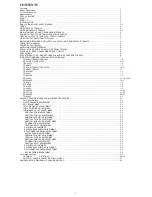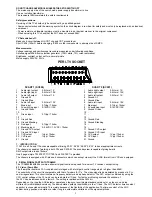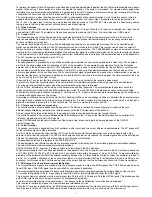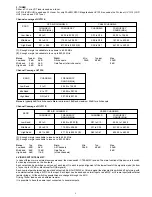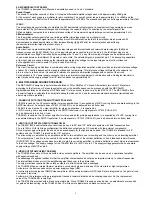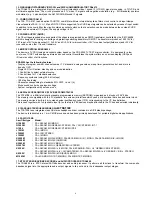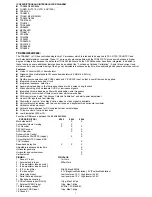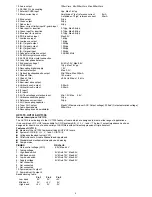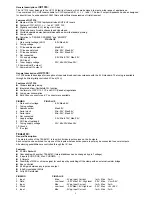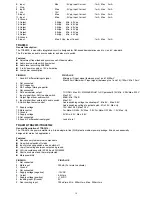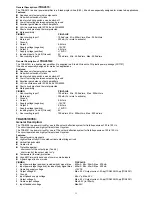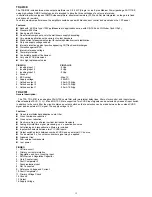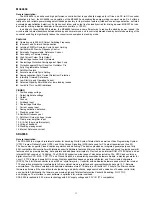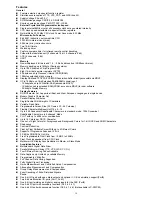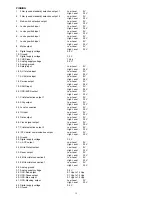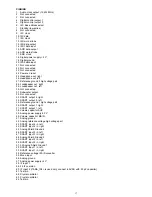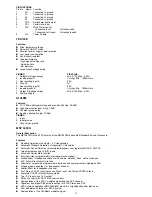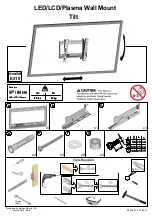
5
5. AM DEMODULATOR TDA9830
The TDA9830 is designed for AM-sound demodulation used in L and L standard.
Sound IF Input:
The sound IF amplifier consists of three AC-coupled differential amplifier stages each with approximately 20dB gain.
At the output of each stage is a multiplier for gain controlling. The overall control range is approximately -6 to +60dB and the
frequency response (-3dB) of the IF amplifier is approximately 6 to 70MHz. The steepness of gain control is approximately 10mV/dB.
IF AGC:
The automatic gain control voltage to maintain the AM demodulator output signal at a constant level is generated by a mean
level detector.The AGC-detector charges and discharges the capacitor at pin 3 controlled by the output signal of the
AM-demodulator compared to an internal reference voltage.The maximum charge/discharge current is approximately 5 mA.
AM-demodulator
The IF amplifier output signal is fed to a limiting amplifier (two stages) and to a multiplier circuit.
However the limiter output signal (which is not any more AM modulated) is also fed to the multiplier, which provides AM
demodulation (in phase demodulation). After lowpass filtering (fg @ 400kHz) for carrier rejection and buffering,
the demodulator output signal is present at pin 6.
Audio Switch
This circuit is an operational amplifier with three input stages and internal feedback network determining gain (0dB) and
frequency response (fg @ 700kHz). Two of the input stages are connected to pin 7 and pin 9, the third input stage to an
internal reference voltage. Controlled by the switching pins 10 and 12, one of the three input stages can be activated and a
choice made between two different AF signals or mute state. The selected signal is present at pin 8. The decoupling capacitors
at the input pins are needed, because the internally generated bias voltage for the input stages must not be influenced
by the application in order to avoid DC-plop in case of switching.
Reference Circuit:
This circuit is a band gap stabiliser in combination with a voltage regulation amplifier, which provides an internal reference voltage
of about 3.6V nearly independent from supply voltage and temperature. This reference voltage is filtered by the capacitor at
pin 4 in order to reduce noise. It is used as a reference to generate all important voltages and currents of the circuit.
For application in 12V power supply concepts, there is an internal voltage divider in combination with a Darlington transistor in
order to reduce the supply voltage for all IC function blocks to approximately 6V.
6. MULTISTANDARD SOUND PROCESSOR
:
The MSP 34x0D is designed to perform demodulation of FM or AM-Mono TV sound. Alternatively, two-carrier FM systems
according to the German or Korean terrestrial specs or the satellite specs can be processed with the MSP 34x0D.
Digital demodulation and decoding of NICAM-coded TV stereo sound, is done only by the MSP 3410. The MSP 34x0D offers
a powerful feature to calculate the carrier field strength which can be used for automatic standard detection (terrestrial) and
search algorithms (satellite).
7. SOUND OUTPUT STAGE TDA2614/TDA2615/TDA2616Q
TDA2614 is used as the AF output amplifier for mono applications. It is supplied by ±12VDC coming from a separate winding in the
SMPS transformer. An output power of 2*6W (THD=0.5%) can be delivered into an 8ohm load.
TDA2615 is used as the AF output amplifier for stereo applications. It is supplied by
±12VDC coming from a separate winding in the SMPS transformer. An output power of 2*6W (THD=0.5%)
can be delivered into an 8ohm load.
TDA2616Q is used as the AF output amplifier for stereo and dolby prologic applications. It is supplied by ±16VDC coming from
a separate winding in the SMPS transformer. An output power of 2*12W (THD=0.5%) can be delivered into an 8ohm load.
8. VERTICAL OUTPUT STAGE WITH TDA8351/8356
The TDA8351/8356 vertical deflection circuit can be used in 90° and 110° deflection systems with field frequencies from
50 up to 120Hz. With its bridge configuration the deflection output can be DC coupled with few external components.
Only a single supply voltage for the scan and a second supply for the flyback are needed. The TDA8356 is intended for 90°
systems and the TDA8351 is intended for 110° systems.
The drive voltage is amplified by an amplifier and fed to two amplifiers, one is inverting and the other is a non inverting amplifier.
The outputs (pins 7 and 4) are connected to the series connection of the vertical deflection coil and feedback resistor Rsense
(R702//R703). The voltage across Rsense is fed via pin 9 to correction amplifier, to obtain a deflection current which is proportional
to the drive voltage. The supply voltage for the TDA8351/8356 is 15VDC at pin 3. The supply voltage generator has a separate
supply voltage of 45VDC at pin 6.
9. VIDEO OUTPUT AMPLIFIER TDA6108M
The TDA6108M consists of three monolithic video output amplifiers. The amplifier can be seen as an operational amplifier
with negative feedback.
The advantage of negative feedback is that the amplifier characteristics do not play an important role up to certain frequencies.
The internal flash diodes protect the amplifiers against flash over in the picture tube.
The only protections required at the cathode outputs are a flash resistor and a sparkgap.
The TDA6108M has an internal thermal protection circuit which gives a decrease of the slew rate at high temperatures.
Furthermore, the device needs only one power supply voltage (Vdd).
In contrast to previous types of DMOS video amplifiers, all the external resistors (Rf, Ri and Ra) are integrated, so the gain is fixed
and saves 9 resistors.
Furthermore, the reference voltage is integrated, it saves a resistor divider and a decoupling capacitor. So, the replacement
value of the TDA6108MQ is very high.
The TDA6108M is provided with a black current data pin. Since TDA884X is used as drive device, no adjustments are required
for gain and black setting, as the TDA884X has I²C white point adjustment and black current set-up.


